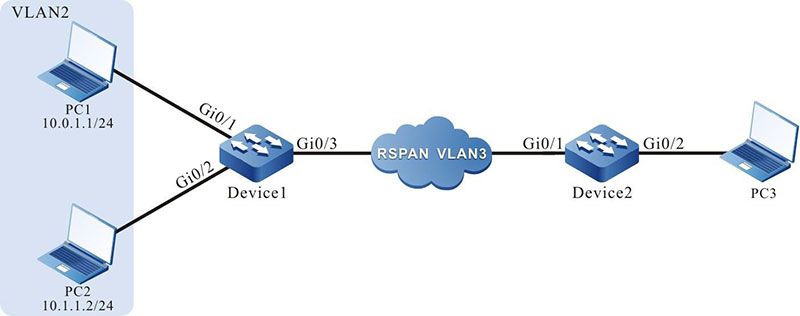Network Requirements
- PC1 and PC2 are connected with Device1 and communicate with each other in VLAN2; PC3 is connected with Device2.
- Configure RSPAN on Device1 and Device2; PC3 monitors the packets received and sent by port gigabitethernet0/1 of Device1 via RSPAN VLAN3.
Network Topology

Figure 5-2 Networking of configuring the RSPAN
Configuration Steps
Step 1: Configure the link type of the VLAN and port.
#Create VLAN2 on Device1. Device1#configure terminal Device1(config)#vlan 2
|
Device1#configure terminal
Device1(config)#vlan 2
Device1(config-vlan2)#exit
|
#Configure the link type of port gigabitethernet0/1 and gigabitethernet0/2 on Device1 as Access, permitting the services of VLAN2 to pass.
|
Device1(config)#interface gigabitethernet 0/1-0/2
Device1(config-if-range)#switchport mode access
Device1(config-if-range)#switchport access vlan 2
Device1(config-if-range)#exit
|
#Configure the link type of port gigabitethernet0/3 as Trunk on Device1.
|
Device1(config)#interface gigabitethernet 0/3
Device1(config-if-gigabitethernet0/3)#switchport mode trunk
Device1(config-if-gigabitethernet0/3)#exit
|
#Configure the link type of port gigabitethernet0/1 as Trunk on Device2.
|
Device2(config)#interface gigabitethernet 0/1
Device2(config-if-gigabitethernet0/1)#switchport mode trunk
Device2(config-if-gigabitethernet0/1)#exit
|
#Configure the link type of port gigabitethernet0/2 as Hybrid on Device2.
|
Device2(config)#interface gigabitethernet 0/2
Device2(config-if-gigabitethernet0/2)#switchport mode hybrid
Device2(config-if-gigabitethernet0/2)#exit
|
Step 2: Configure RSPAN on Device1 and Device2.
#Configure VLAN3 as RSPAN VLAN on Device1 and configure port gigabitethernet0/3 to permit the services of VLAN3 to pass.
|
Device1(config)#vlan 3
Device1(config-vlan3)#remote-span
Device1(config-vlan3)#exit
Device1(config)#interface gigabitethernet 0/3
Device1(config-if-gigabitethernet0/3)#switchport trunk allowed vlan add 3
Device1(config-if-gigabitethernet0/3)#exit
|
#Configure RSPAN on Device1, the mirror source session is port gigabitethernet0/1, and destination session is port gigabitethernet0/3.
|
Device1(config)#monitor session 1 source interface gigabitethernet 0/1 both
Device1(config)#monitor session 1 destination remote vlan 3 interface gigabitethernet 0/3
|
#View the RSPAN session information on Device1.
Device1#show monitor session all
Session 1
Type : RSPAN Source Session
RSPAN VLAN : 3
Destination Interface : gigabitethernet0/3
Source Interface(both): gi0/1
#Configure VLAN3 as RSPAN VLAN on Device2 and configure port gigabitethernet0/1 to permit the services of VLAN3 to pass.
|
Device2(config)#vlan 3
Device2(config-vlan3)#remote-span
Device2(config-vlan3)#exit
Device2(config)#interface gigabitethernet 0/1
Device2(config-if-gigabitethernet0/1)# switchport trunk allowed vlan add 3
Device2(config-if-gigabitethernet0/1)#exit
|
#Configure RSPAN on Device2, the mirror source session is RSPAN VLAN3, and destination session is port gigabitethernet0/2.
|
Device2(config)#monitor session 1 source remote vlan 3
Device2(config)#monitor session 1 destination interface gigabitethernet 0/2
|
#View the RSPAN session information on Device2.
Device2#show monitor session all
Session 1
Type : RSPAN
Destination Session RSPAN VLAN : 3
Destination Interface : gigabitethernet0/2
Step 3: Check the result.
#When PC1 and PC2 communicate with each other, the packets sent and received by port gigabitethernet0/1 of Device1 can be got on PC3.
 Switch
Switch Wifi - Access Point
Wifi - Access Point Firewall
Firewall Router
Router Module Quang
Module Quang![Module Quang Cisco]() Module Quang Cisco
Module Quang Cisco![Module quang HPE]() Module quang HPE
Module quang HPE![Module quang Maipu]() Module quang Maipu
Module quang Maipu![Module quang Brocade]() Module quang Brocade
Module quang Brocade![Module quang Fortinet]() Module quang Fortinet
Module quang Fortinet![Module quang Aruba]() Module quang Aruba
Module quang Aruba![Module quang OEM]() Module quang OEM
Module quang OEM![Module quang Juniper]() Module quang Juniper
Module quang Juniper![Module quang Dell]() Module quang Dell
Module quang Dell![Module quang Palo Alto]() Module quang Palo Alto
Module quang Palo Alto![Module quang Huawei]() Module quang Huawei
Module quang Huawei![Module quang Arista]() Module quang Arista
Module quang Arista![Module quang F5]() Module quang F5
Module quang F5![Module quang H3C]() Module quang H3C
Module quang H3C![Module Quang Allied Telesis]() Module Quang Allied Telesis
Module Quang Allied Telesis![Module quang SonicWall]() Module quang SonicWall
Module quang SonicWall![Module quang Mikrotik]() Module quang Mikrotik
Module quang Mikrotik![Module quang Handar]() Module quang Handar
Module quang Handar Máy chủ (Server)
Máy chủ (Server) Thiết bị lưu trữ (SAN, NAS)
Thiết bị lưu trữ (SAN, NAS) Load Balancing
Load Balancing Video Conferencing
Video Conferencing Phụ kiện máy chủ
Phụ kiện máy chủ Thiết Bị IoT
Thiết Bị IoT Phụ Kiện Mạng
Phụ Kiện Mạng




.png)
























